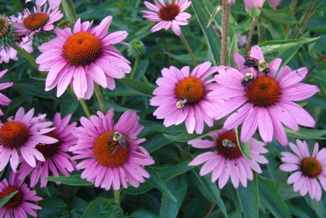 Looking for a maintenance free perennial to liven up your landscape all throughout summer? Echinacea may be the ticket.
Looking for a maintenance free perennial to liven up your landscape all throughout summer? Echinacea may be the ticket.
Botanical and Common Name: Echinacea is often called Purple Coneflower. The prominent cone-shaped center of each daisy-like flower gave the plant its common name. Many folks now drop the “purple” and refer to the flowers simply as Coneflowers because the colors available now are varied.
Hardiness Zones: Echinacea is very hardy and versatile growing well in zones 3-8. Some varieties specified below do well even in the humid summers of zones 9 and 10.
Bloom Time & Color: Echinacea blooms all summer and flowers are traditionally purple.
Plant Category: Coneflowers are herbaceous perennials.
Foliage: Echinacea has dark-green, coarsely toothed leaves that are attractive.
Growth Habit: Echinacea are traditionally multi-stemmed plants with bushy, upright growth and large flower stalks that lift the coneflowers well above the plant base.
Dimensions: Most plants in the Echinacea family grow about 2-4′ tall and about 2′ wide.
Preferred Conditions: Coneflowers prefer full sun but will tolerate partial shade conditions. It does well in average or poor soil and Echinacea has a thick tap-root that grows deep to allow for water conservation once established.
Maintenance: Sometimes staking is needed to keep the tall Echinacea flower stalks from breaking in windy areas. Deadheading coneflowers through the summer will keep blooms coming for weeks on end. Self-sown seedlings may appear but not in uncontrollable numbers. Leaving the seed heads at the end of the season provides seeds that are highly attractive to native songbirds such as goldfinches.
Pests or Diseases: No serious pests or diseases impact the Echinacea.
Propagation Methods: Coneflowers can be grown from seeds sown outdoors or purchased as started plants.
Seasons of Interest: Spring foliage is dark green and attractive. Echinacea blooms all summer long and into the beginning of fall as well. Some gardeners choose to leave the coneflower seed heads on the plant at the end of the season to provide winter interest and food for native songbirds.





